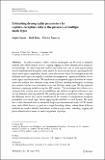Files in this item
Estimating demographic parameters for capture-recapture data in the presence of multiple mark types
Item metadata
| dc.contributor.author | Smout, Sophie Caroline | |
| dc.contributor.author | King, Ruth | |
| dc.contributor.author | Pomeroy, Patrick | |
| dc.date.accessioned | 2013-02-08T14:31:01Z | |
| dc.date.available | 2013-02-08T14:31:01Z | |
| dc.date.issued | 2011-06-01 | |
| dc.identifier | 413463 | |
| dc.identifier | eac68506-f236-42ff-82ed-69599ddbf7c9 | |
| dc.identifier | 79957609554 | |
| dc.identifier.citation | Smout , S C , King , R & Pomeroy , P 2011 , ' Estimating demographic parameters for capture-recapture data in the presence of multiple mark types ' , Environmental and Ecological Statistics , vol. 18 , no. 2 , pp. 331-347 . https://doi.org/10.1007/s10651-010-0135-y | en |
| dc.identifier.issn | 1352-8505 | |
| dc.identifier.other | standrews_research_output: 25598 | |
| dc.identifier.other | ORCID: /0000-0003-1603-5630/work/46569088 | |
| dc.identifier.uri | https://hdl.handle.net/10023/3344 | |
| dc.description.abstract | In mark-recapture studies, various techniques can be used to uniquely identify individual animals, such as ringing, tagging or photo-identification using natural markings. In some long-term studies more than one type of marking procedure may be implemented during the study period. In these circumstances, ignoring the different mark types can produce biased survival estimates since the assumption that the different mark types are equally catchable (homogeneous capture probability across mark types) may be incorrect.We implement an integrated approach where we simultaneously analyse data obtained using three different marking techniques, assuming that animals can be cross-classified across the different mark types. We discriminate between competing models using the AIC statistic. This technique also allows us to estimate both relative mark-loss probabilities and relative recapture efficiency rates for the different marking methods.We initially perform a simulation study to explore the different biases that can be introduced if we assume a homogeneous recapture probability over mark type, before applying the method to a real dataset. We make use of data obtained from an intensive long-term observational study of UK female grey seals (Halichoerus grypus) at a single breeding colony, where three different methods are used to identify individuals within a single study: branding, tagging and photo-identification based on seal coat pattern or pelage. | |
| dc.format.extent | 161265 | |
| dc.language.iso | eng | |
| dc.relation.ispartof | Environmental and Ecological Statistics | en |
| dc.subject | Mark-recapture | en |
| dc.subject | Mark-loss | en |
| dc.subject | Halichoerus grypus | en |
| dc.subject | Multiple mark types | en |
| dc.subject | Integrated analysis | en |
| dc.subject | QA Mathematics | en |
| dc.subject | QL Zoology | en |
| dc.subject.lcc | QA | en |
| dc.subject.lcc | QL | en |
| dc.title | Estimating demographic parameters for capture-recapture data in the presence of multiple mark types | en |
| dc.type | Journal article | en |
| dc.contributor.sponsor | EPSRC | en |
| dc.contributor.sponsor | EPSRC | en |
| dc.contributor.institution | University of St Andrews. Scottish Oceans Institute | en |
| dc.contributor.institution | University of St Andrews. School of Mathematics and Statistics | en |
| dc.contributor.institution | University of St Andrews. School of Biology | en |
| dc.contributor.institution | University of St Andrews. Marine Alliance for Science & Technology Scotland | en |
| dc.contributor.institution | University of St Andrews. Sea Mammal Research Unit | en |
| dc.identifier.doi | https://doi.org/10.1007/s10651-010-0135-y | |
| dc.description.status | Peer reviewed | en |
| dc.identifier.url | http://www.scopus.com/inward/record.url?scp=79957609554&partnerID=8YFLogxK | en |
| dc.identifier.grantnumber | EP/D049911/1 | en |
| dc.identifier.grantnumber | EP/D049911/1 | en |
This item appears in the following Collection(s)
Items in the St Andrews Research Repository are protected by copyright, with all rights reserved, unless otherwise indicated.

